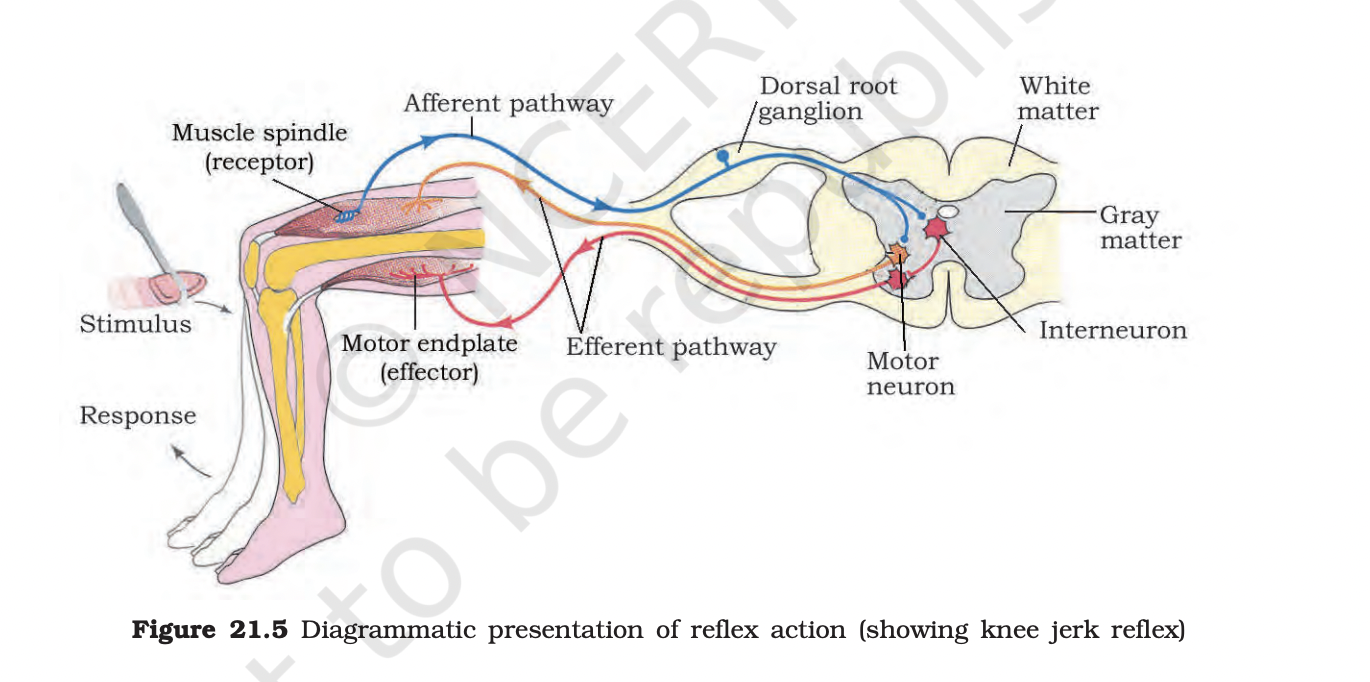11.REFLEX ACTION AND REFLEX ARC
You must have experienced a sudden withdrawal of a body part which comes in contact with objects that are extremely hot, cold pointed or animals that are scary or poisonous.
The entire process of response to a peripheral nervous stimulation, that occurs involuntarily, i.e., without conscious effort or thought and requires the involvment of a part of the central nervous system is called a reflex action.
The reflex pathway comprises at least one afferent neuron (receptor) and one efferent (effector or excitor) neuron appropriately arranged in a series (Figure 21.5).
The afferent neuron receives signal from a sensory organ and transmits the impulse via a dorsal nerve root into the CNS (at the level of spinal cord).
The efferent nueuron then carries signals from CNS to the effector.
The stimulus and response thus forms a reflex arc as shown below in the knee jerk reflex.
 FLEX ACTION AND REFLEX ARCYou must have experienced a sudden withdrawal of a body part whichcomes in contact with objects that are extremely hot, cold pointed oranimals that are scary or poisonous. The entire process of response to aperipheral nervous stimulation, that occurs involuntarily, i.e., withoutconscious effort or thought and requires the involvment of a part of thecentral nervous system is called a reflex action. The reflex pathwaycomprises at least one afferent neuron (receptor) and one efferent (effectoror excitor) neuron appropriately arranged in a series (Figure 21.5). Theafferent neuron receives signal from a sensory organ and transmits theimpulse via a dorsal nerve root into the CNS (at the level of spinal cord).The efferent nueuron then carries signals from CNS to the effector. Thestimulus and response thus forms a reflex arc as shown below in theknee jerk reflex. You should carefully study Figure 21.5 to understandthe mechanism of a knee jerk reflex.g
FLEX ACTION AND REFLEX ARCYou must have experienced a sudden withdrawal of a body part whichcomes in contact with objects that are extremely hot, cold pointed oranimals that are scary or poisonous. The entire process of response to aperipheral nervous stimulation, that occurs involuntarily, i.e., withoutconscious effort or thought and requires the involvment of a part of thecentral nervous system is called a reflex action. The reflex pathwaycomprises at least one afferent neuron (receptor) and one efferent (effectoror excitor) neuron appropriately arranged in a series (Figure 21.5). Theafferent neuron receives signal from a sensory organ and transmits theimpulse via a dorsal nerve root into the CNS (at the level of spinal cord).The efferent nueuron then carries signals from CNS to the effector. Thestimulus and response thus forms a reflex arc as shown below in theknee jerk reflex. You should carefully study Figure 21.5 to understandthe mechanism of a knee jerk reflex.g